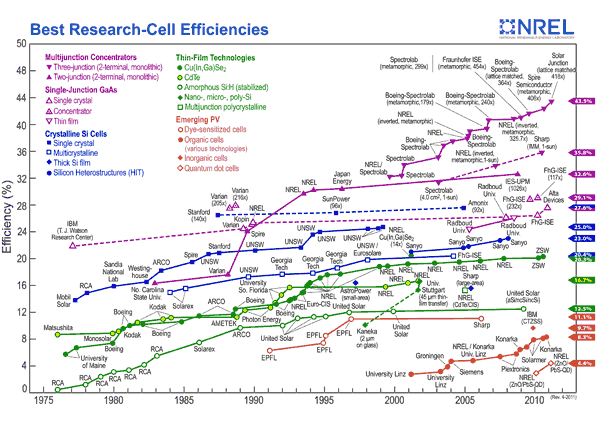New efficiency record for solar cells
California startup Alta Devices has developed a photocell with an efficiency of 28.2%, which is a new world record for photovoltaic cells (FEP). This is close to the Shockley-Kweisser fundamental limit, which is 33.7% for a cell with one pn junction, 42% for a two-layer cell, 49% for a three-layer cell, and 68% for a hypothetical cell with an infinite number of layers.
Over the past twenty years, the maximum efficiency for photoelectric converters with a single-stage transition was 26.1%, only recently it was succeeded to increase it to 26.4%, so experts call the result of Alta Devices a real breakthrough.
From the point of view of quantum chemistry, about the following occurs inside the FEP: electrons of matter absorb the incoming photons and transfer to new energy levels. Depending on the energy of each individual photon (that is, the frequency of light), an electron can go into electricity (that is, leave the cell), go into thermal radiation and form new photons with lower energy (longer wavelength). These secondary photons trigger the same reaction, and so on, until the photon's wavelength falls below the red border of the photoelectric effect .
The approach of Alta Devices to the Shockley-Heisser limit was made possible by a significant increase in the "utilization" of photons in the photocell. The secret is to add a film of very high-quality gallium arsenide (GaAs) with a thickness of 1 micron to the FEP. The structure is such that it utilizes up to 99% of “secondary” recombinations into photons. The co-founder of Alta Devices has invented a new method of growing GaAs film, with which you can get a better crystal lattice. In addition, Alta Devices increased the reflectivity of the coating of the photocell, so that the photons do not leave the FEP.
')
Representatives of Alta Devices presented their design at the IEEE Photovoltaic Specialist Conference on June 20, 2011.
Improving the efficiency of solar cells even by a few percent can significantly reduce their payback period. Although the listed results up to 28.2% are achievable only in laboratory conditions, and when assembling real solar modules, the efficiency is noticeably reduced, but Alta Devices executive director Christopher Norris is quite sure that they can achieve 30% in the laboratory and assemble ready-made modules for commercial use with an efficiency of around 26% (in double-layer cells, even higher). In this case, solar energy will be quite competitive with fossil fuels.
Now Alta Devices is trying to build an assembly line to produce the first batch of solar cells. The company has already raised $ 72 million in investment and grants for technical process improvement.

In the diagram, the achievement of Alta Devices is designated as 27.6%, because it is this figure that was in the official report at the IEEE Photovoltaic Specialist Conference (apparently, it was already tested in an independent laboratory), but in fact, shortly after the conference, Alta Devices reported an increase Efficiency up to 28.2%.
via IEEE Spectrum
Over the past twenty years, the maximum efficiency for photoelectric converters with a single-stage transition was 26.1%, only recently it was succeeded to increase it to 26.4%, so experts call the result of Alta Devices a real breakthrough.
From the point of view of quantum chemistry, about the following occurs inside the FEP: electrons of matter absorb the incoming photons and transfer to new energy levels. Depending on the energy of each individual photon (that is, the frequency of light), an electron can go into electricity (that is, leave the cell), go into thermal radiation and form new photons with lower energy (longer wavelength). These secondary photons trigger the same reaction, and so on, until the photon's wavelength falls below the red border of the photoelectric effect .
The approach of Alta Devices to the Shockley-Heisser limit was made possible by a significant increase in the "utilization" of photons in the photocell. The secret is to add a film of very high-quality gallium arsenide (GaAs) with a thickness of 1 micron to the FEP. The structure is such that it utilizes up to 99% of “secondary” recombinations into photons. The co-founder of Alta Devices has invented a new method of growing GaAs film, with which you can get a better crystal lattice. In addition, Alta Devices increased the reflectivity of the coating of the photocell, so that the photons do not leave the FEP.
')
Representatives of Alta Devices presented their design at the IEEE Photovoltaic Specialist Conference on June 20, 2011.
Improving the efficiency of solar cells even by a few percent can significantly reduce their payback period. Although the listed results up to 28.2% are achievable only in laboratory conditions, and when assembling real solar modules, the efficiency is noticeably reduced, but Alta Devices executive director Christopher Norris is quite sure that they can achieve 30% in the laboratory and assemble ready-made modules for commercial use with an efficiency of around 26% (in double-layer cells, even higher). In this case, solar energy will be quite competitive with fossil fuels.
Now Alta Devices is trying to build an assembly line to produce the first batch of solar cells. The company has already raised $ 72 million in investment and grants for technical process improvement.

In the diagram, the achievement of Alta Devices is designated as 27.6%, because it is this figure that was in the official report at the IEEE Photovoltaic Specialist Conference (apparently, it was already tested in an independent laboratory), but in fact, shortly after the conference, Alta Devices reported an increase Efficiency up to 28.2%.
via IEEE Spectrum
Source: https://habr.com/ru/post/123485/
All Articles